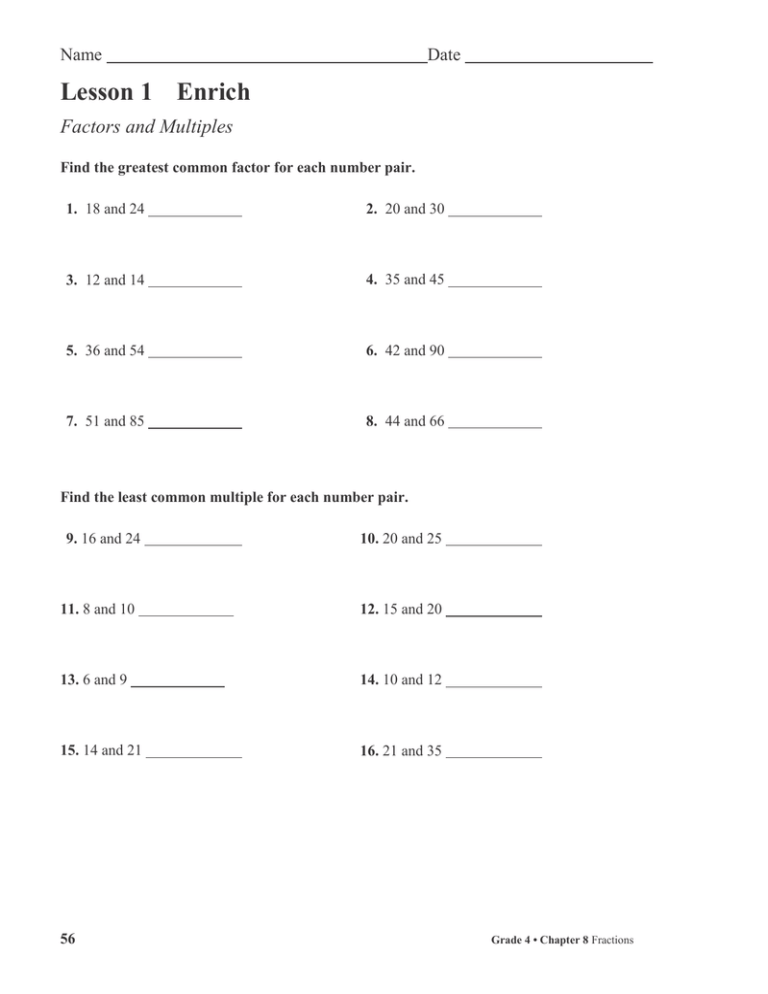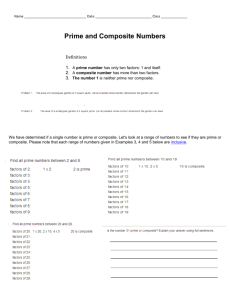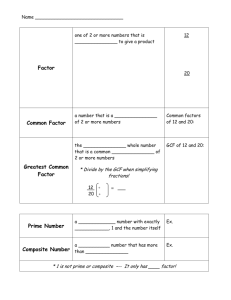Review of Lessons 1 and 2
advertisement

Name Date Lesson 1 Enrich Factors and Multiples Find the greatest common factor for each number pair. 1. 18 and 24 2. 20 and 30 3. 12 and 14 4. 35 and 45 5. 36 and 54 6. 42 and 90 7. 51 and 85 8. 44 and 66 Find the least common multiple for each number pair. 9. 16 and 24 10. 20 and 25 11. 8 and 10 12. 15 and 20 13. 6 and 9 14. 10 and 12 15. 14 and 21 16. 21 and 35 56 Grade 4 • Chapter 8 Fractions Name Date Lesson 2 Reteach Prime and Composite Numbers Jeanne is organizing her books in a bookcase. There are the same number of books in each row. If Jeanne has 16 books, how many ways can she arrange them? You need to find all the factors of 16 to find out how many ways Jeanne can arrange her books. 1 × 16 = 16 or 16 × 1 = 16 16 1 8 2 × 8 = 16 or 8 × 2 = 16 2 4 4 × 4 = 16 4 The books can be arranged in five ways, 1 × 16, 16 × 1, 2 × 8, 8 × 2, or 4 × 4. So, the factors of 16 are 1, 2, 4, 8, and 16. A number like 16 that has more than two factors is a composite number. A number that has only two factors is a prime number. The factors of 2 are 1 and 2. 2 has exactly two factors, 1 and 2, so it is a prime number. Find the factors of each number. Then tell whether the number is composite or prime. 1. 4 2. 9 3. 7 4. 27 Solve. 5. Design a bulletin board with rows and columns for 32 drawings. Decide if 32 is a prime or composite number. List all the ways to arrange the drawings. 64 Grade 4 • Chapter 8 Fractions Name Date Lesson 2 Enrich Prime and Composite Numbers “Air” + “Toss the Knees” That’s how to pronounce the name of an ancient Greek thinker — Eratosthenes! He figured out a good way to sort prime numbers and composite numbers. Follow these directions to try out his method. 1 2 3 4 5 6 7 8 9 10 11 12 13 14 15 16 17 18 19 20 21 22 23 24 25 26 27 28 29 30 31 32 33 34 35 36 37 38 39 40 41 42 43 44 45 46 47 48 49 50 Directions 1. Cross out 1. 2. Circle the number 2, and then cross out every multiple of 2. 3. Circle the number 3, and then cross out every multiple of 3. (Be sure to count the numbers that are already crossed out, like 6.) 4. Notice that 4 is already crossed out. 5. Circle the number 5, and then cross out every multiple of 5. 6. Find the next number that is not crossed out – it’s 7. Circle the number 7, and then cross out every multiple of 7. 7. Continue the same process until you have circled all the prime numbers and crossed out all the composite numbers. 8. List the prime numbers less than 50. If you would like to know more about Eratosthenes, you can read about him in The Librarian Who Measured the Earth, by Kathryn Laskey. Grade 4 • Chapter 8 Fractions 57 Name Date Lesson 1 Reteach Factors and Multiples Find the factor pairs for 18. Think of multiplication equations that result in a product of 18. 1 × 18 = 18 1 and 18 are a factor pair of 18. 2 × 9 = 18 2 and 9 are a factor pair of 18. 3 × 6 = 18 3 and 6 are a factor pair of 18. 1 and the number itself are factor pairs for any number. So, the factor pairs for 18 are 1 and 18, 2 and 9, and 3 and 6. Determine whether 104 is a multiple of 8. One way: divide 104 by 8 13 8) 104 –8 24 –24 0 Another way: skip count by 8 104 can be divided evenly by 8, with no remainder. So, 104 is a multiple of 8. 8, 16, 24, 32, 40, 48, 56, 64, 72, 80, 88, 96, 104 You can count by 8 to get to 104, so 104 is a multiple of 8. Find the factor pairs for each number. 1. 9 2. 28 3. 31 and and and and and and For exercises 4–11, write yes or no. 4. Is 32 a multiple of 6? 5. Is 81 a multiple of 9? 6. Is 98 a multiple of 7? Is 7. Is 24 a multiple of 7? 8. 70 a multiple of 5? Is 9. Is 37 a multiple of 6? 10. 64 a multiple of 9? Grade 4 • Chapter 8 Fractions 11. Is 45 a multiple of 9? 63




